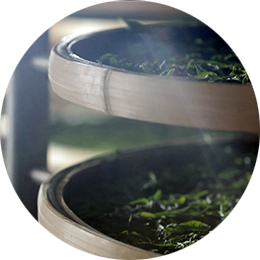El analizador de humedad rápido halógeno se utiliza principalmente para medir el contenido de agua del té y otros alimentos, con una precisión del 0,01 %. El medidor de humedad es de tamaño pequeño y rápido en la medición, que es adecuado para varias plantas de té
Máquina formadora de prensa de té de tipo plano principalmente para LongJing Tea, a través del programa de control de la computadora, los procesos de operación manual como la alimentación del té, la fijación, la conformación plana, el pulido se cambian al control de la computadora, de modo que se puede ajustar la uniformidad de cada lote de té y controlado
La máquina laminadora de té DL-6CRT-75 tiene doble acción, principalmente para torcer té, diámetro del tambor de 75 cm, capacidad de aproximadamente 120 kg por lote.
DL-6CQFJ-70 utilizado para clasificar las hojas frescas que recoge la cosechadora de té, puede separar diferentes tamaños de té para producir diferentes grados de té terminado.
DL-CRQ-20Z CTC té negro HRS Gyrovane rotorvane máquina utilizada principalmente para procesar té negro CTC.
DL-6CYQT-90250 utilizado principalmente para el procesamiento de té Oolong, tambor hecho de bambú, la actividad del té marchito aumentó al agitarlo, puede hacer que el té tenga un sabor más fragante, capacidad de aproximadamente 120 kg por lote.
DL-6CHL-RQ10 es una máquina de secado de té de tipo pequeño, puede secar todo tipo de té, utiliza calefacción a gas, capacidad de 40 kg a 600 kg por hora, temperatura y velocidad ajustables, seguridad, ahorro de energía y protección del medio ambiente
DL-6CHZ-9QB es un deshidratador de té de acero inoxidable completo, calefacción eléctrica, área de secado de aproximadamente 10 metros cuadrados, capacidad de 27-45 kg por lote.
Debido a que las hojas de té recién recolectadas tienen más humedad y el olor a hierba es más fuerte, deben colocarse en una habitación fresca y ventilada para que se marchiten. Después de marchitarse, el contenido de agua de las hojas de té se reduce, las hojas se vuelven blandas y el olor a hierba desaparece. y se revela el aroma de las hojas de té, lo que favorece el procesamiento posterior, como fijación, torsión, fermentación, etc. El color, el sabor y la calidad del té verde son mejores que el té sin marchitarse.

Spread out the tea leaves on the ground (need to lay a layer of plastic cloth, etc. to prevent tea leaves from directly contacting the ground). This method is the most primitive and the simplest method. Advantages: save money, less trouble, hardly need any input, about 2.5 kg/㎡ of tea leaves can be placed Disadvantage: It is only suitable for the production of small batches of tea. If large quantities of tea leaves are produced, the required space is very large; if it encounters rainy weather, it can only be placed in the room to wither.
Place the fresh leaves on the withering racks, each withering rack has 20 layers, and each layer has a whole bamboo sieve tray. There are mesh holes on the sieve tray to facilitate air flow. At the same time, bamboo strips can absorb water, increase the rate of water evaporation, and accelerate the speed of tea leaves withering. Advantage: Small footprint; each withering tray can hold 2.5 kg of fresh leaves, and each shelf (about 1.2 square meters) can hold 50 kg of fresh leaves, which greatly saves space; at the same time, the withering tray is made of bamboo, which is clean, hygienic and environmentally friendly . There is a pulley at the bottom of the machine, which makes it easier to move.
Put the fresh leaves on the withering machine. The withering machine can place 40 kg of tea leaves per square meter. The machine can blow air from the bottom of the tea leaves, which can adjust the temperature of the wind, greatly increasing the withering speed of the tea leaves. Advantages: Small area, hot air can be blown in, greatly improved the withering speed (efficiency increased by about 70%) Disadvantages: The machine needs to be heated, the power is about 15kw, and it needs to be connected to a 380V power supply.